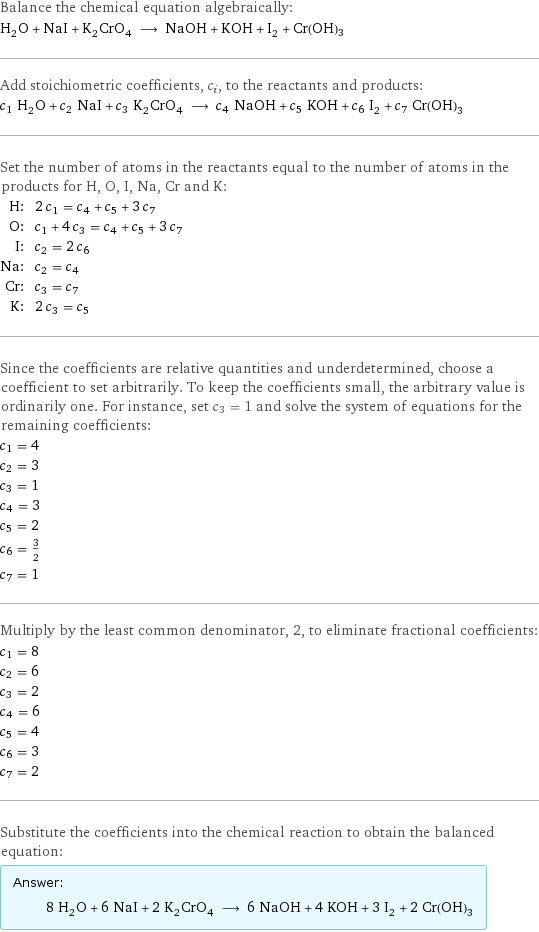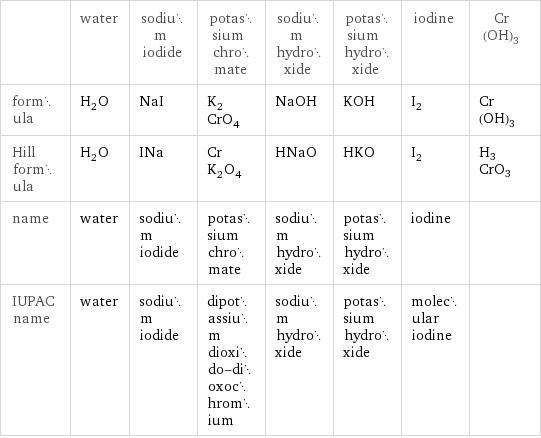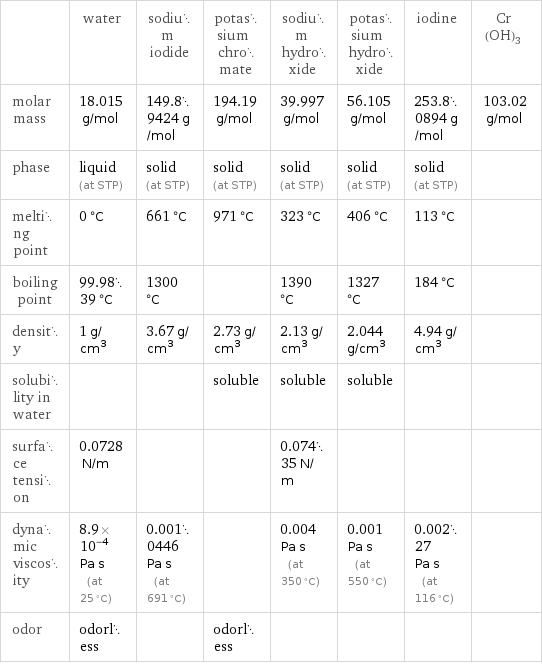Input interpretation

H_2O water + NaI sodium iodide + K_2CrO_4 potassium chromate ⟶ NaOH sodium hydroxide + KOH potassium hydroxide + I_2 iodine + Cr(OH)3
Balanced equation

Balance the chemical equation algebraically: H_2O + NaI + K_2CrO_4 ⟶ NaOH + KOH + I_2 + Cr(OH)3 Add stoichiometric coefficients, c_i, to the reactants and products: c_1 H_2O + c_2 NaI + c_3 K_2CrO_4 ⟶ c_4 NaOH + c_5 KOH + c_6 I_2 + c_7 Cr(OH)3 Set the number of atoms in the reactants equal to the number of atoms in the products for H, O, I, Na, Cr and K: H: | 2 c_1 = c_4 + c_5 + 3 c_7 O: | c_1 + 4 c_3 = c_4 + c_5 + 3 c_7 I: | c_2 = 2 c_6 Na: | c_2 = c_4 Cr: | c_3 = c_7 K: | 2 c_3 = c_5 Since the coefficients are relative quantities and underdetermined, choose a coefficient to set arbitrarily. To keep the coefficients small, the arbitrary value is ordinarily one. For instance, set c_3 = 1 and solve the system of equations for the remaining coefficients: c_1 = 4 c_2 = 3 c_3 = 1 c_4 = 3 c_5 = 2 c_6 = 3/2 c_7 = 1 Multiply by the least common denominator, 2, to eliminate fractional coefficients: c_1 = 8 c_2 = 6 c_3 = 2 c_4 = 6 c_5 = 4 c_6 = 3 c_7 = 2 Substitute the coefficients into the chemical reaction to obtain the balanced equation: Answer: | | 8 H_2O + 6 NaI + 2 K_2CrO_4 ⟶ 6 NaOH + 4 KOH + 3 I_2 + 2 Cr(OH)3
Structures

+ + ⟶ + + + Cr(OH)3
Names

water + sodium iodide + potassium chromate ⟶ sodium hydroxide + potassium hydroxide + iodine + Cr(OH)3
Equilibrium constant
![Construct the equilibrium constant, K, expression for: H_2O + NaI + K_2CrO_4 ⟶ NaOH + KOH + I_2 + Cr(OH)3 Plan: • Balance the chemical equation. • Determine the stoichiometric numbers. • Assemble the activity expression for each chemical species. • Use the activity expressions to build the equilibrium constant expression. Write the balanced chemical equation: 8 H_2O + 6 NaI + 2 K_2CrO_4 ⟶ 6 NaOH + 4 KOH + 3 I_2 + 2 Cr(OH)3 Assign stoichiometric numbers, ν_i, using the stoichiometric coefficients, c_i, from the balanced chemical equation in the following manner: ν_i = -c_i for reactants and ν_i = c_i for products: chemical species | c_i | ν_i H_2O | 8 | -8 NaI | 6 | -6 K_2CrO_4 | 2 | -2 NaOH | 6 | 6 KOH | 4 | 4 I_2 | 3 | 3 Cr(OH)3 | 2 | 2 Assemble the activity expressions accounting for the state of matter and ν_i: chemical species | c_i | ν_i | activity expression H_2O | 8 | -8 | ([H2O])^(-8) NaI | 6 | -6 | ([NaI])^(-6) K_2CrO_4 | 2 | -2 | ([K2CrO4])^(-2) NaOH | 6 | 6 | ([NaOH])^6 KOH | 4 | 4 | ([KOH])^4 I_2 | 3 | 3 | ([I2])^3 Cr(OH)3 | 2 | 2 | ([Cr(OH)3])^2 The equilibrium constant symbol in the concentration basis is: K_c Mulitply the activity expressions to arrive at the K_c expression: Answer: | | K_c = ([H2O])^(-8) ([NaI])^(-6) ([K2CrO4])^(-2) ([NaOH])^6 ([KOH])^4 ([I2])^3 ([Cr(OH)3])^2 = (([NaOH])^6 ([KOH])^4 ([I2])^3 ([Cr(OH)3])^2)/(([H2O])^8 ([NaI])^6 ([K2CrO4])^2)](../image_source/02d79bd1e29cff047036765c236614c8.png)
Construct the equilibrium constant, K, expression for: H_2O + NaI + K_2CrO_4 ⟶ NaOH + KOH + I_2 + Cr(OH)3 Plan: • Balance the chemical equation. • Determine the stoichiometric numbers. • Assemble the activity expression for each chemical species. • Use the activity expressions to build the equilibrium constant expression. Write the balanced chemical equation: 8 H_2O + 6 NaI + 2 K_2CrO_4 ⟶ 6 NaOH + 4 KOH + 3 I_2 + 2 Cr(OH)3 Assign stoichiometric numbers, ν_i, using the stoichiometric coefficients, c_i, from the balanced chemical equation in the following manner: ν_i = -c_i for reactants and ν_i = c_i for products: chemical species | c_i | ν_i H_2O | 8 | -8 NaI | 6 | -6 K_2CrO_4 | 2 | -2 NaOH | 6 | 6 KOH | 4 | 4 I_2 | 3 | 3 Cr(OH)3 | 2 | 2 Assemble the activity expressions accounting for the state of matter and ν_i: chemical species | c_i | ν_i | activity expression H_2O | 8 | -8 | ([H2O])^(-8) NaI | 6 | -6 | ([NaI])^(-6) K_2CrO_4 | 2 | -2 | ([K2CrO4])^(-2) NaOH | 6 | 6 | ([NaOH])^6 KOH | 4 | 4 | ([KOH])^4 I_2 | 3 | 3 | ([I2])^3 Cr(OH)3 | 2 | 2 | ([Cr(OH)3])^2 The equilibrium constant symbol in the concentration basis is: K_c Mulitply the activity expressions to arrive at the K_c expression: Answer: | | K_c = ([H2O])^(-8) ([NaI])^(-6) ([K2CrO4])^(-2) ([NaOH])^6 ([KOH])^4 ([I2])^3 ([Cr(OH)3])^2 = (([NaOH])^6 ([KOH])^4 ([I2])^3 ([Cr(OH)3])^2)/(([H2O])^8 ([NaI])^6 ([K2CrO4])^2)
Rate of reaction
![Construct the rate of reaction expression for: H_2O + NaI + K_2CrO_4 ⟶ NaOH + KOH + I_2 + Cr(OH)3 Plan: • Balance the chemical equation. • Determine the stoichiometric numbers. • Assemble the rate term for each chemical species. • Write the rate of reaction expression. Write the balanced chemical equation: 8 H_2O + 6 NaI + 2 K_2CrO_4 ⟶ 6 NaOH + 4 KOH + 3 I_2 + 2 Cr(OH)3 Assign stoichiometric numbers, ν_i, using the stoichiometric coefficients, c_i, from the balanced chemical equation in the following manner: ν_i = -c_i for reactants and ν_i = c_i for products: chemical species | c_i | ν_i H_2O | 8 | -8 NaI | 6 | -6 K_2CrO_4 | 2 | -2 NaOH | 6 | 6 KOH | 4 | 4 I_2 | 3 | 3 Cr(OH)3 | 2 | 2 The rate term for each chemical species, B_i, is 1/ν_i(Δ[B_i])/(Δt) where [B_i] is the amount concentration and t is time: chemical species | c_i | ν_i | rate term H_2O | 8 | -8 | -1/8 (Δ[H2O])/(Δt) NaI | 6 | -6 | -1/6 (Δ[NaI])/(Δt) K_2CrO_4 | 2 | -2 | -1/2 (Δ[K2CrO4])/(Δt) NaOH | 6 | 6 | 1/6 (Δ[NaOH])/(Δt) KOH | 4 | 4 | 1/4 (Δ[KOH])/(Δt) I_2 | 3 | 3 | 1/3 (Δ[I2])/(Δt) Cr(OH)3 | 2 | 2 | 1/2 (Δ[Cr(OH)3])/(Δt) (for infinitesimal rate of change, replace Δ with d) Set the rate terms equal to each other to arrive at the rate expression: Answer: | | rate = -1/8 (Δ[H2O])/(Δt) = -1/6 (Δ[NaI])/(Δt) = -1/2 (Δ[K2CrO4])/(Δt) = 1/6 (Δ[NaOH])/(Δt) = 1/4 (Δ[KOH])/(Δt) = 1/3 (Δ[I2])/(Δt) = 1/2 (Δ[Cr(OH)3])/(Δt) (assuming constant volume and no accumulation of intermediates or side products)](../image_source/2049b626bf53bee5e94c216315170d5b.png)
Construct the rate of reaction expression for: H_2O + NaI + K_2CrO_4 ⟶ NaOH + KOH + I_2 + Cr(OH)3 Plan: • Balance the chemical equation. • Determine the stoichiometric numbers. • Assemble the rate term for each chemical species. • Write the rate of reaction expression. Write the balanced chemical equation: 8 H_2O + 6 NaI + 2 K_2CrO_4 ⟶ 6 NaOH + 4 KOH + 3 I_2 + 2 Cr(OH)3 Assign stoichiometric numbers, ν_i, using the stoichiometric coefficients, c_i, from the balanced chemical equation in the following manner: ν_i = -c_i for reactants and ν_i = c_i for products: chemical species | c_i | ν_i H_2O | 8 | -8 NaI | 6 | -6 K_2CrO_4 | 2 | -2 NaOH | 6 | 6 KOH | 4 | 4 I_2 | 3 | 3 Cr(OH)3 | 2 | 2 The rate term for each chemical species, B_i, is 1/ν_i(Δ[B_i])/(Δt) where [B_i] is the amount concentration and t is time: chemical species | c_i | ν_i | rate term H_2O | 8 | -8 | -1/8 (Δ[H2O])/(Δt) NaI | 6 | -6 | -1/6 (Δ[NaI])/(Δt) K_2CrO_4 | 2 | -2 | -1/2 (Δ[K2CrO4])/(Δt) NaOH | 6 | 6 | 1/6 (Δ[NaOH])/(Δt) KOH | 4 | 4 | 1/4 (Δ[KOH])/(Δt) I_2 | 3 | 3 | 1/3 (Δ[I2])/(Δt) Cr(OH)3 | 2 | 2 | 1/2 (Δ[Cr(OH)3])/(Δt) (for infinitesimal rate of change, replace Δ with d) Set the rate terms equal to each other to arrive at the rate expression: Answer: | | rate = -1/8 (Δ[H2O])/(Δt) = -1/6 (Δ[NaI])/(Δt) = -1/2 (Δ[K2CrO4])/(Δt) = 1/6 (Δ[NaOH])/(Δt) = 1/4 (Δ[KOH])/(Δt) = 1/3 (Δ[I2])/(Δt) = 1/2 (Δ[Cr(OH)3])/(Δt) (assuming constant volume and no accumulation of intermediates or side products)
Chemical names and formulas

| water | sodium iodide | potassium chromate | sodium hydroxide | potassium hydroxide | iodine | Cr(OH)3 formula | H_2O | NaI | K_2CrO_4 | NaOH | KOH | I_2 | Cr(OH)3 Hill formula | H_2O | INa | CrK_2O_4 | HNaO | HKO | I_2 | H3CrO3 name | water | sodium iodide | potassium chromate | sodium hydroxide | potassium hydroxide | iodine | IUPAC name | water | sodium iodide | dipotassium dioxido-dioxochromium | sodium hydroxide | potassium hydroxide | molecular iodine |
Substance properties

| water | sodium iodide | potassium chromate | sodium hydroxide | potassium hydroxide | iodine | Cr(OH)3 molar mass | 18.015 g/mol | 149.89424 g/mol | 194.19 g/mol | 39.997 g/mol | 56.105 g/mol | 253.80894 g/mol | 103.02 g/mol phase | liquid (at STP) | solid (at STP) | solid (at STP) | solid (at STP) | solid (at STP) | solid (at STP) | melting point | 0 °C | 661 °C | 971 °C | 323 °C | 406 °C | 113 °C | boiling point | 99.9839 °C | 1300 °C | | 1390 °C | 1327 °C | 184 °C | density | 1 g/cm^3 | 3.67 g/cm^3 | 2.73 g/cm^3 | 2.13 g/cm^3 | 2.044 g/cm^3 | 4.94 g/cm^3 | solubility in water | | | soluble | soluble | soluble | | surface tension | 0.0728 N/m | | | 0.07435 N/m | | | dynamic viscosity | 8.9×10^-4 Pa s (at 25 °C) | 0.0010446 Pa s (at 691 °C) | | 0.004 Pa s (at 350 °C) | 0.001 Pa s (at 550 °C) | 0.00227 Pa s (at 116 °C) | odor | odorless | | odorless | | | |
Units
